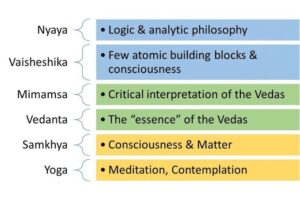INTRODUCTION:
A word has two separate significant functions. The first which is: śakti, The denotation or the primary function meaning. The second is lāksaṇa Which is the secondary or implication function. These aggregations are primarily caused by the will of the God or by the human conventions as per the logical school of Indian philosophy, which is Nyāy darśan. This place is a very significant role in comprehending things into the right perspective in relation to the epistemological understanding of the division of words.
A word is having two different parts. The first one which is sabda It has wider aspect when it gains the potency which becomes pada. And the second part of this manifestation, which is pada: It is having a central order a value and a force and has more important Association and assimilation to the denotation functions. It is much like the word and the meaning, the meaning and the object or let us say, “pada + artha = padhartha”.
MAIN ASPECT:
There are four categories of denoted functions, and as per those the primary category is that of: Yaugika– Which is the denotation category where in the meaning is grasped on part of the word. It has a functional aspect associated with it. For example, in the case of The word Pācaka (to cook). Then we are having the second category, which is the Rūdha: That is the conventional meaning where the word is driving, its significance from the rude etymological meaning of the particular given word. Here the meaning is grasped as per the denotation function of the whole word, and not on the basis of the denoted function of the parts of the word. The meaning is having a wider respect associated with it, which has to be selected as per the usage of the term or the word. For example, in the case of the term gomanḍālam Which means the globe.
Then we are having the third category of the denotation word, which is, Denotatively conventional: the Yogruḍha: Here the meaning is grasped as per the denotation function of the part of the word, which is including incorporating significantly, the denotation function of the word as a whole. In this particular category of denotation, We are having meanings which the word is already having, but we need to select as per the context. For example, in the case of the word Paṇkajā Which means something that has its origination from the mud, but is called as the lotus Flower.
Then we have the manifestation of this denotation, which is called the Yaugika Rūdha: Denotation and convention. In this, the word is having a particular function and is also indicating the conventional aspect. It has its focus on the direction or the beginning and has a focal aspect. The conventional meaning, and the denotative meaning Are obtained independently of each other. As in the case of the word, which is: Uḍbḥīda, This word is indicating that it could be something that is upwards as in the case of tree, herb or shrubs But it also has a traditional understanding of being viewed as a religious sacrifice.
CONCLUSION:
It has been argued on critical terms by RamRudra that the word “Pācaka” cannot be under the category of Yaugika. But it could argued against this objection that, The suffix “aka” which is coming after root word “pac” is having “denotative function” in the agent, I.e., Pachaka iti pācaka, therefore, pācaka is rightfully in the yaugika category.
As per Dr. Dibyendu Bhattacharya: “Nyaya Philosophy objects are nine – (1) Prthibi (earth), (2) Ap (water), (3) Tejas (fire), (4) Vayu (air), (k5) Akasa, (6) Kala (Time), (7) Dik (Space), (8) Ataman (Self), (9) Manas (Mind).”
Then comes another criticism, that is again highlighted by Ramrudra, that Gaomandalam is not rightfully one word, and Dinakara further expands this by asserting that if you take Gaumanḍālam in the compound form, it is Gaomandaladi which is divided into, Go meaning cow and mandala meaning the globe, two words, hence not correct to place it in Rūdha category. Ramarūdra takes Mandala interpretation of the Muktavalikara text of Nyāy darśan. Simply because if we will take “Mandapa ” here it could mean a wide array of multitudes of meanings if used with Mandam pibāti which could be understood as: The man who is drinking the scum of boiled rice. And then there is another interpretation, which comes from the Sentence, Mandanam Rakṣhati which means, The man is protecting the scum of the boiled rice. Here, the word mandapa Could be understood, By plethora of meanings Such as a Marriage pavilion, etc.
REFERENCES:
https://kudbhattacharyya.com/wp-content/uploads/2020/10/Module-2_Educational_Philosophy.pdf
https://www.srimatham.com/uploads/5/5/4/9/5549439/nyaya_philosophy.pdf
NYAYA SIDDHANTA MUKTAVALI, Central Sanskrit university. Pdf: https://sanskrit.nic.in/DigitalBook/N/Nyayasiddhantamuktavali.pdf





















